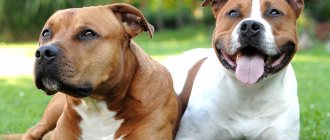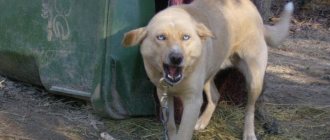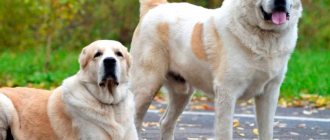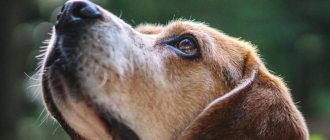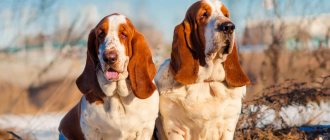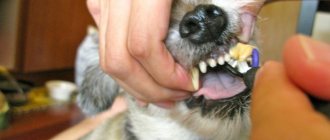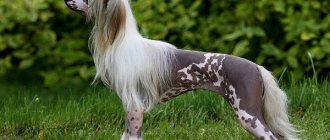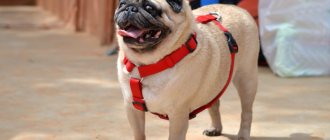Your heart will be healthier
Owners of dogs less than Dog Ownership and Survival are at risk of dying from cardiovascular disease.
And all thanks to regular cardio exercises. You can skip running training, but not walking your dog. Both in the snow and in the heat, you have to take a leash and leave the house. Even lazy tramping from foot to foot while your pet is looking for a suitable bush already contributes to heart health. What can we say about long hikes and exercises with a dog. This beneficial effect is even more pronounced for people who have suffered a heart attack or stroke. For them, having a dog reduces the risk of death from cardiovascular diseases by 31%.
What breeds are not advisable to have in an apartment?
There are several breeds that are not recommended to be taken into an apartment:
- Doberman and other guard breeds - they can be aggressive and unbalanced, dangerous for adults and even more so for children;
- Alabai - such large dogs need spacious enclosures. Like the Doberman, it can be poorly controlled and unpredictable, and has a complex character;
- German Shepherd - despite its intelligence, this dog is not suitable for an apartment because it needs regular physical activity, training and long walks;
- The Rottweiler is a hardy dog that needs an enclosure and intensive training, and in the conditions of an ordinary city apartment it can chew furniture;
- Jack Russell Terrier is a small but hyperactive dog, also temperamental and arrogant, requiring long-term walking;
- The Saint Bernard is a giant dog that will feel uncomfortable in an apartment even due to its size. In addition, he does not tolerate heat very well, and his long hair and increased salivation will cause a lot of inconvenience when cleaning;
- The Bullmastiff is another powerful guard dog that needs a large territory. Unbalanced, aggressive and poorly controlled.
This is not a complete list of dogs that are not recommended to be kept in an apartment. It is better not to have large breeds of dogs, as well as those that are hyperactive, too aggressive, prone to excessive shedding, cause allergies and require long walks.
You won't feel alone
Photo: Christin_Lola / Depositphotos
As we have already found out, a dog helps to find new friends, so if the owner of the animal is lonely, then not for long. And until he makes new acquaintances, the dog will not let him become despondent. Research from Companion dog acquisition and mental well-being: a community-based three-arm controlled study shows that thanks to daily interactions with a pet, a person is less sad and homesick. And in general, pets stabilize mood and reduce the risk of depression.
Is it worth getting a husky dog?
Huskies have their advantages for living in an apartment - for example, the fact that they are not too large, are hypoallergenic, and their coat is capable of self-cleaning. Huskies are clean and affectionate to their owner. But the disadvantages outweigh.
Firstly, these dogs have a rather short but thick coat with undercoat - and this means problems during shedding 1-2 times a year (depending on the gender of the dog).
Secondly, huskies are a freedom-loving breed that is used to living in Taiga, and in an apartment it can chew furniture. And not out of harm - it’s just that huskies do not tolerate loneliness well. This may lead to the pet simply deciding to run away.
Thirdly, Huskies are not meant to be human companions - they have problems with communication, and training a dog of this breed is unlikely to be successful.
Pros and cons of cats
Cats are one of the most popular animals on Earth; the number of these amazing creatures on the planet has long exceeded 500 million. And this figure is approximate, since only pets were taken into account in the calculation, but poor homeless people were not included in this figure. Do cats have virtues? There are a lot of them, let’s try to list just a few:
- Cats heal owners.
And this is not a myth, but a scientifically proven skill. Sound therapy for any cat, regardless of breed, promotes rapid fusion of bones and healing of diseased joints, pacifies heart pain and respiratory problems, relieves inflammation, and lifts its owner out of depression; - Cats are real clean people.
It is believed that they spend 30-40% of their waking time washing their coat. This means that there will be no unpleasant smell from the animal in the house; - Cats are usually unobtrusive.
Yes, many of them love affection, but in fairly limited quantities. As a rule, purrs know how to entertain themselves on their own, but dogs will have to devote much more time. When buying a cat first, you can be sure that communicating with her will not require much time; in the future, it will be enough to raise a dog; - Cats do not need to be taken outside every day.
This is a valuable advantage over dogs, who still have to be walked with in the rain or cold. Cats can relieve themselves at home, making puddles and piles in the tray; - Keeping a cat costs the owner less than keeping a dog
(if you don’t take into account pocket breed dogs that eat little). Agree that any cat, even a big Maine Coon, will eat less compared to, say, an Alabai or a Great Dane; - Cats are quiet animals.
Yes, they can sing serenades during the heat, but the rest of the time they are much quieter than dogs, which not only bark, but also sometimes howl; - Cats do not require much space; they can be kept even in a small apartment.
Dogs need more space; - Cats rid the house of uninvited guests in the form of rats or mice
, which often annoy the owners of private houses. And some mustaches even catch cockroaches and centipedes; - Cats live longer than dogs.
On average, a domestic cat with good care can live up to 15-18 years (and this is not the limit), but among dogs only small dogs like Chihuahuas are considered long-lived; - A cat can be safely left in an apartment for a couple of hours, or even a day
(provided that the animal has access to water and food). After eating, your pet will most likely curl up in a ball and doze off. This is important for busy people who do not spend much time within the walls of their apartment. You can't leave your dog alone for long.
Well, cats have many advantages. But these animals also have disadvantages, which we list below:
- Cats are very capricious.
Unlike dogs, they may not care about their owner. Often domestic cats or cats have such a dominant character that they try to do everything in defiance of the owner: they sleep in the bed, and not on their bed, they pee under the bed, not in the tray; - Cats are almost impossible to train.
They are capable of learning some commands (for example, “You can’t!”), but you still won’t get the same obedience from them as from dogs; - Playing with cats often ends in tears, namely scratches and bites.
Moreover, they can cause pain both to a stranger and to their own owner if he, say, touched the tail or stroked it a little longer than possible; - Cats hate traveling.
Being in a car or public transport is fraught with stress for them. While driving, many cats scream loudly, try to run away, and scratch the owner’s hands. Dogs in this regard are much more mobile and calmer; - Some cat owners complain that they cause significant damage to property:
they chew flowers and overturn pots, and tear up furniture upholstery. Let us note in fairness that not all pussies are guilty of this; - Usually cats shed more heavily than dogs
, unless we are talking about hairless breeds like the Sphynx or Levkoy; - Almost all cats are unsociable animals.
They may ask for affection occasionally, but will spend most of their time alone. They will not tolerate minute-to-minute communication in the form of stroking and scratching. This is worth considering for those people who have small children; - Many cats, and especially male cats, love to mark.
And not always only during the “love” period. The unpleasant smell of cat urine can piss off even the most patient owner. It can be very difficult to wean your pet from such an activity; - Cats are vindictive creatures
, and therefore they remember even a small insult for a long time. Dogs “cool down” much faster.
Conclusion: a cat is an ideal pet for calm introverts, busy, elderly and, oddly enough, lazy people.
What breeds do well in an apartment?
There are a lot of dogs that will feel good in an ordinary city apartment. Among them are American or French bulldogs, chixyaks, Pomeranians, dachshunds, Yorkshire terriers and pugs, poodles and cocker spaniels. These breeds do well within four walls, do not tend to chew furniture or damage property, practically do not shed or smell, do not need too long walks and tolerate several hours alone well. They can become reliable and loyal friends who will look forward to their owner getting home from work every evening.
Keeping a dog: how and when to start training
An important part of owning a dog is training it. The ideal pets for companionship with humans are those that are easy to train. As you know, the dog is highly trainable. Even if you adopted a dog without a breed and do not expect anything special from it, at least minimal education and training are necessary. There are many examples when owners themselves spoil a dog that is not naturally stupid and obedient - for example, they take it to bed with them or teach it to say goodbye to the table, do not stop theft or barking for no reason. And when it comes to large fighting breeds, lack of training can have fatal consequences for both you and those around you.
Description of appearance
The breed standard introduced by the RKF in the mid-20th century classified the Scottish Shepherd as a large dog. The height of males then reached 69 cm, and females - up to 64 cm. Almost the same standards are still in force in the USA: the height at the withers for a male is 61-66 cm, for a female - 56-61 cm. But according to the ICF collie standard belongs to medium-sized breeds. Its variety, the Sheltie, is also popular. The height of these dogs does not exceed 41 cm, and their weight is about 10 kg.
The Scottish Shepherd is a beautiful dog with a graceful build, but stately and hardy, with a proud bearing. She is proportionally built, moves gracefully and easily. With a fairly large stature, the weight of a male should be no more than 34 kg, and that of a female – up to 26 kg. The appearance features also include a narrow fox muzzle, expressive intelligent eyes and lush long hair.
The pictures illustrate the appearance features:
Head
The head is medium in size, proportional to the body. Elongated, wedge-shaped. The cheekbones are flat, the stop is weakly expressed. The jaws are strong, with a scissor bite. The lips are dry, black, and do not sag. The bridge of the nose is slightly rounded, the lobe is large and black.
The eyes are almond-shaped and set obliquely. This gives the muzzle a slightly sly expression. Eye color is usually dark, but blue coloring and even heterochromia are acceptable for marbled collies. The ears are small, triangular, set high. Usually the collie will hold them back against her head, but if she is excited, the ears will stand up and the tips will droop.
Body type
The neck is muscular, long, beautifully arched. The physique is harmonious, the body is elongated. The lower back is raised, the chest is deep, the stomach is tucked. The tail is long and hangs down when at rest. The tip may be slightly raised. Never throws itself onto its back or bends into a ring.
Limbs
The forelimbs are smooth, thin, and placed close to each other. Elbows point back. The hind legs are muscular, the hock joints are well defined. Paws are oval, toes arched. The dog moves easily and springily.
Photos complement the description of the collie:
Wool
The fur is thick and completely covers the entire body. The guard hair is hard, long, straight. Forms a lush mane and collar on the neck, feathering on the paws and tail. The hair on the head is short. The undercoat is dense, dense and soft.
Colors
The standard allows only three collie colors:
- sable - from golden to dark red;
- tricolor or tricolor - a combination of black, white and red, the main color of such dogs should be black, red tan on the legs and head;
- marbled or blue merle - silver-blue color with dark spots, large black spots are unacceptable.
Regardless of color, the dog should have a white collar, shirt front, white spots on the paws and the tip of the tail. They can also be on the face. In some countries, white collies are found. Only their head and tail are colored. Such individuals are obtained from crossing two marbled parents. This is not officially permitted by the standard, and such coloring is not recognized. White puppies are often born with genetic defects.
Varieties
Previously, Scottish collies were only long-haired. Since the 20th century, short-haired representatives of the breed have also been distinguished. There are several other varieties of collies:
- bearded or birdie - a very rare breed, with long hair on the head, characteristic eyebrows, beard and mustache;
- Border Collies are the smartest representatives of the breed, their hair is of medium length;
- Sheltie is a miniature copy of the long-haired representatives of the breed, their weight does not exceed 10 kg.
Sometimes Australian Shepherds and Australian Kelpies are also classified as collies.
The photographs show how long-haired representatives of the breed differ from other varieties:
Border Collie
Sheltie
Bearded Collie
Welcome puppy
At a family council it was decided to get a dog. A breed has been chosen and a lot of information has been read about it. And now there is a puppy in the house. On the very first night, he keeps him awake with his crying, calming down only if someone sits with him and pets him. This continues for several days. And finally, she forces him to take him to bed. The puppy calmly falls asleep and learns his lesson: to achieve his goal, you need to cry. And sofas and beds become his favorite places to relax.
The family is having breakfast. The puppy asks for food from the table - it smells so delicious, not like what’s in his bowl! Someone can’t stand it and treats the baby. Now he will always beg for food, refusing food. A little picky boy is growing up. In addition to the fact that this will cause disturbances in the structure of his body, such a habit creates disobedience - in a pack the leader eats separately.
After a short time, the puppy becomes aggressive, as hormones begin to be released, and his upbringing is lame. He wants to become the leader of the pack. After suffering a little, the owners give him into good hands. Why did this happen? They did not take into account the need for systematic dog education. The pros and cons of training could be learned in advance.
Health problems, difficult care
Most pug owners claim that this is a very sickly breed.
Allergies, gastrointestinal diseases, molting, problems with the eyes, ears, teeth, and most importantly, a fold on the nose. But is everything really so terrible? Does every pug really face frequent visits to the veterinarian, constant medications and other difficulties? Responsibility for the health of the pug lies with its owner. Of course, it is not uncommon to end up with a puppy that is initially problematic.
In this case, the parents who had any health problems are “to blame” (and, again, they were raised and raised by people). But this is a separate topic, namely, how to choose the right pug puppy.
In other cases, if a puppy or adult dog is constantly sick, it means that the owner has made some serious mistakes in its maintenance.
As for allergies (the most common ailment among pugs), it is most often caused by dangerous foods that are present in the dog’s diet. For example, a baby pug should not be given fruits, honey or other treats. In order not to provoke allergies, this breed needs proper, not varied nutrition.
We recommend reading: How to properly feed your dog natural food?
To avoid diseases associated with the eyes, folds, ears and oral cavity, you simply need to take care of them regularly. Procedures such as cleaning ears, trimming nails, wiping the nasal fold and others take a minimum of time.
If the owner is lazy to properly care for the dog or does not consider it necessary to find out as much useful information on this topic as possible, then as a result he is faced with constant diseases of the pug and large financial costs.
Origin story
The birthplace of the breed is Great Britain. Researchers believe that the ancestors of the collie were brought to the island by the Romans. There they mixed with the herding aboriginal shepherd dogs. They became most popular in Scotland, where there were many farmers who raised sheep. According to one version, the name “collie” came from the word colleys, which meant black sheep. They also began to call the dogs that herded these animals. The name was established already in the 17th century.
For many years, collie dogs helped shepherds. There were almost no predators in Scotland, so the shepherd did not need ferocity and great strength. She only had to make sure that the sheep did not fall behind. Therefore, the collie turned out to be not aggressive, responsible, but hardy and agile. Thick fur protected it from bad weather, and large muscular paws made it easy to move in mountainous areas. Then these dogs were more squat, the main color was black and white.
By the end of the 19th century, the breed became popular among ordinary dog breeders. Not only the working qualities of the collies were appreciated, but also their calm, peaceful character. They began to be bred as companions. Representatives of the breed began to be crossed with greyhounds and setters. A red color appeared, the height became taller, the muzzle became elongated. In 1885, collies similar to modern ones were exhibited at an exhibition. Long-haired and smooth-haired varieties of the breed were distinguished separately.
At the beginning of the 20th century, Scottish Shepherds came to America and quickly gained popularity there. The oldest collie kennels are now located in the United States. They appeared in Russia during the reign of Nicholas II. In these countries, larger collies were bred than Scottish ones.
In Russia, these dogs were used mainly for service purposes, they served in the army, in the police, and therefore had a more aggressive character. The RKF standard was slightly different from the international one. Only in the 90s, thanks to the import of breeding specimens from abroad, more good-natured and shorter representatives of the breed began to appear.
